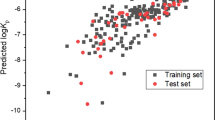Abstract
A general mathematical model involving partition coefficient, molecular weight and hydrogen bonding has been formulated for correlating the structures and skin permeability of a wide range of compounds through human skin and through hairless mouse skin. The correlations obtained are dependent not only on the biological system but also on the vehicle used. Without the use of lipophilic vehicle, the ideal lipophilicity for maximum permeability through human skin as measured by log Po(oct/w)ranges from 2.5 to 6 (extrapolated value). When a lipophilic vehicle was used in hairless mouse skin study, the log Po(oct/w) was lowered to around 0.4 ~ 0.6. While increased M.W. always has a negative effect on the permeability, increased H-bond can have either a slight positive or a slight negative effect, depending on the experiments (absorption vs. permeability constant). Cross validations with previously unanalyzed data as well as other biological systems support the usefulness of the general model developed for passive diffusion.
Similar content being viewed by others
REFERENCES
P. Peters, C. Cooper, K. Maiorama, and M. L. Graeme. The effect of topically applied agents on ultraviolet erythemia in guinea pigs. Agents Actions 7, 545–553 (1977).
T. Inukai, H. Awata, K. Kurokawa, M. Adachi, Y. Nakanishi, and Y. Nagao. Antiinflammatory and analgesic effects of indomethacin ointment (Japanese). Jpn. Pharmacol. Ther. 7, (suppl 1) 3–13 (1979).
S. Naito and Y. Tsai. Percutaneous absorption of indomethacin from ointment bases in rabbits. Int. J. Pharm. 8, 263–276 (1981).
T. Yano, K. Furukawa, E. Araki, R. Natsuki, M. Tsuji, K. Noda, M. Shibuya, and T. Aoyama. Studies on metabolic fate of 2-pyridylmethyl-2[p-(2-methyl-propyl)phenyl]-propionate (pimaprofen) percutaneous absorption in rats and men. Pharmacometrics 23, 603–609 (1982).
T. Yano, A. Nakagawa, M. Tsuji, and K. Noda. Skin permeability of various non-steroidal anti-inflammatory drugs in man. Life Sci. 39, 1043–1050 (1986).
R. J. Scheuplein and R. L. Bronaugh. Percutaneous absorption. In: L. A. Goldsmith (ed.), Biochemistry and Physiology of the Skin, Oxford University Press, New York, 1983, pp. 1255–1295.
C. Hansch and A. Leo. The Log P Database, Pomona College Medicinal Chemistry Project, Technical Database Services, Inc., New York, 1973.
C. K. Lee, T. Uchida, K. Kitagawa, A. Yagi, N. S. Kim, and S. Goto. Skin permeability of various drugs with different lipophilicity. J. Pharm. Sci. 83, 562–565 (1994).
S. Goto, T. Uchida, C. K. Lee, T. Yasutake, and J. B. Zhang. Effect of various vehicles on ketoprofen permeation across excised hairless mouse skin. J. Pharm. Sci. 82, 959–963 (1993).
E. J. Lien. Physicochemical properties and gastrointestinal absorption of drugs. Drug Intell. Clin. Pharmacol. 4, 7–9 (1970).
E. J. Lien, R. T. Koda, and G. L. Tong. Buccal and percutaneous absorptions. Drug Intell. Clin. Pharmacol. 5, 38–41 (1971).
E. J. Lien. The relationship between chemical structure and drug absorption, distribution, and excretion. In: J. Maas (ed.), Medicinal Chemistry IV, Proceedings of the 4th Int. Symp. on Med. Chem., Amsterdam, 1974, pp. 319–342.
E. J. Lien. Structure-absorption-distribution relationships for bioactive compounds: Its significance for drug design. In E. J. Ariens (ed.), Drug Design Academic Press, New York, 1976, pp. 81–132.
E. J. Lien. Structures, properties and disposition of drugs. Prog. Drug Res. 29, 67–95 (1985).
A. E. Bird and A. C. Marshall. Correlation of serum binding of penicillins with partition coefficients. Biochem. Pharmacol. 16, 2275–2290 (1967).
C. Hansch, E. J. Lien, and F. Helmer. Structure-activity correlations in the metabolism of drugs. Arch. Biochem. Biophys. 128, 319–330 (1968).
R. O. Potts and R. H. Guy. Predicting skin permeability. Pharm. Res. 9, 663–669 (1992).
R. J. Scheuplein. Mechanism of percutaneous absorption. I. Routes of penetration and the influence of solubility. J. Invest. Dermatol. 45, 334–348 (1965).
R. J. Scheuplein, I. J. Blank, and G. J. Brauner, D. J. MacFarlane. Percutaneous absorption of steroids. J. Invest. Dermatol. 52, 63–70 (1969).
E. J. Lien, L. L. Lien, and H. Gao. Structure-system activity relationship analysis of drug disposition. 10th European Symposium on Structure-Activity Relationships: QSAR and Molecular Modelling. September 4–9, 1994, Barcelona, Spain.
Rights and permissions
About this article
Cite this article
Lien, E.J., Gaot, H. QSAR Analysis of Skin Permeability of Various Drugs in Man as Compared to in Vivo and in Vitro Studies in Rodents. Pharm Res 12, 583–587 (1995). https://doi.org/10.1023/A:1016266316100
Issue Date:
DOI: https://doi.org/10.1023/A:1016266316100




